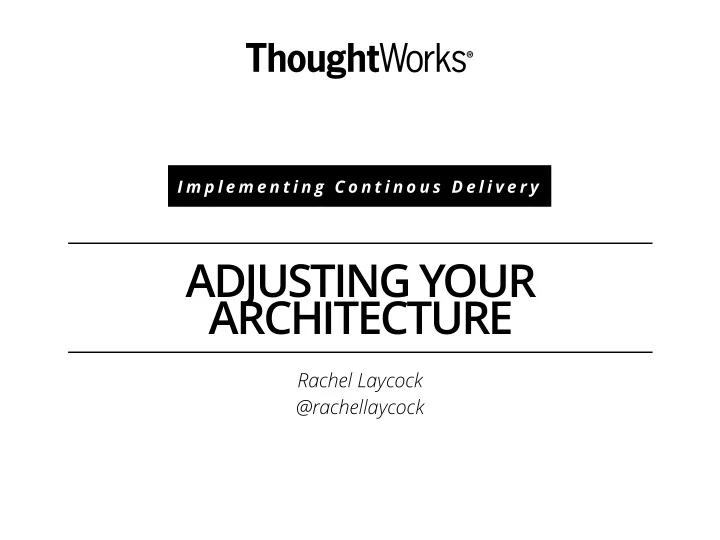

I m p l e m e n t i n g C o n t i n o u s D e l i v e r y ADJUSTING YOUR ARCHITECTURE Rachel Laycock @rachellaycock
continuous delivery Our highest priority is to satisfy the customer through early and continuous delivery of valuable software
“You can’t have Continuous Delivery”
“Once upon a time I was a happy developer…"
“I thought I knew what Continuous Delivery was”
“I was doing CD on my projects”
“Then one day…"
“...a client wanted Continuous Delivery”
...and we said “sure”
“...but 3 months later they were still asking…"
“Are we there yet?”
Their code base was huge and complex
1. Conway’s Law is THE LAW 2. Keep things small 3. Evolve your architecture
continuous delivery is big Organisational Alignment Release Management Quality Continuous Configuration Data Environments Architecture Assurance Integration Management Management & Deployment
stu ff that is hard to change
?
civil architecture
town planning
1. CONWAY’S LAW IS THE LAW 20
conway’s law “organizations which design systems ... are constrained to produce designs which are copies of the communication structures of these organizations” —Melvin Conway
Melvin Conway: “Because the design that occurs fi rst is almost never the best possible , the prevailing system concept may need to change. Therefore, fl exibility of organisation is important to e ff ective design.”
the wrong side of the law
layered / tiered architecture User In Inte terface Channels Channels Applicati tion Bu Business Logic & Rules Middleware Middleware Servi vices platf tform Data tabase Sys yste tems of Record
current state IOS Android Mobile web web Shared web web
problems? IOS Android Mobile web web Shared web web
ball of mud
a real ball of mud
“expediency over design” - Brian Foot & Joseph Yoder
technical debt http://martinfowler.com/bliki/images/techDebtQuadrant.png
coupling problems code artifact afferent efferent
Software architecture represents the tension between coupling & cohesion. 32
problems? IOS Android Mobile web web Shared web web
brownfield
untangling God Object : an object that knows too much or does too much
metrics
strangler pattern
the law on your side
“team designs are the fi rst draft of your architecture” - Michael Nygard
vertical teams
inverse conway manoeuvre Build teams that look like the architecture you want (and it will follow).
the new world payments statements rewards
continuous delivery Teams with low e ff erent coupling deliver relatively independently into a common integration pipeline (without fearing breaking each others builds).
2. KEEP THINGS SMALL ` 44
small, single responsibility small enough to fi t in your head rewrite over maintain (10—1000 LOC)-ish / service single responsibility
decentralised governance
preparing for the unknown future Rachel is much smarter than present Rachel
“with great power…”
“fine grained SOA…?”
Products Customers
user interface server-side DBA
traditional monolith Model User Interface
ball of mud
monolith drawbacks Complexity increases Hard to change Low reusability Slow to deploy Testing takes time High cognitive load Reliability and scale is hard
enter SOA Explicit Boundaries Shared Contract and Schema, not class Policy Driven Autonomous http://www.infoq.com/articles/tilkov-10-soa-principles
Product Customer
What “Traditional” SOA Got Right Breaking monoliths into services Focus on integration over internal coupling Prefer BASE to ACID What “Traditional” SOA Missed Architecture is abstract until operationalized. Impact of Conway’s Law The folly of trying to build “Uber” services ( Customer ) Didn’t support easy change (ESB pattern)
so microservices? 59
fallacies of distributed computing 1.The network is reliable. 2.Latency is zero. 3.Bandwidth is in fi nite. 4.The network is secure. 5.Topology doesn't change. 6.There is one administrator. 7.Transport cost is zero. 8.The network is homogeneous.
principles SOA Explicit Boundaries Shared Contract and Schema, not class Policy Driven Autonomous http://www.infoq.com/articles/tilkov-10-soa-principles
boundaries are explicit
boundaries are explicit
Shipping Ordering Billing Reporting Catalog
Shipping Ordering Billing Reporting Catalog What about to integration? 65
asynchronous vs synchronous
eventual consistency Publish event Subscribe to event Message Channel
BASE ACID ▫︎ B asic A vailability ▫︎ A tomic ▫︎ S oft-state ▫︎ C onsistent ▫︎ E ventual Consistency ▫︎ I solated ▫︎ D urable As your system becomes more distributed, prefer BASE to ACID… …because CAP Theorem www.julianbrowne.com/article/viewer/brewers-cap-theorem Formal proof: http://lpd.ep fl .ch/sgilbert/pubs/BrewersConjecture-SigAct.pdf
Prefer Choreography to Orchestration pack of enterprise architects Because Conway’ s Law! traditional SOA / ESB pattern
Standardize on integration, not platform …but don’ t go crazy Building Microservices DESIGNING FINE - GRAINED SYSTEMS Have one, two or maybe three ways of integrating, not 20. Sam Newman Building Microservices DESIGNING FINE - GRAINED SYSTEMS Pick some sensible conventions, and stick with them. Sam Newman
hexagonal architecture http://alistair.cockburn.us/Hexagonal+architecture
explicit about coupling engineering safety nets forces coarser- undisciplined coupling = mess grained coupling coupling dynamics become integration issues microservice architectures promote coupling from application to integration architecture.
microservice architectures promote coupling from application to integration architecture. Pros: explicit about coupling dynamics forces coarser-grained coupling points Cons: undisciplined coupling becomes a mess transaction boundaries become an architectural issue
the monolith backlash?
return to the monolith? Components are units of software Component that can be independently replaced and upgraded Libraries and Services are two forms of component Library Service Libraries run within a single process, communicating through language function call mechanisms Services run in separate processes, communicating with networking mechanisms such as HTTP or TCP/IP
partitioning by existing coupling God Object : an object that knows too much or does too much
maturity
Yesterday’ s best practice is tomorrow’ s anti-pattern. We inadvertently build architectures to solve outdated problems.
3. EVOLVE YOUR ARCHITECTURE 79
last responsible moment
all the things to consider Network Security Devices/Hardware Usability
architect for evolvability
http://tutorials.jumpstartlab.com/images/elevate/newrelic_snapshot.jpg
architect for testability
conway’s law
1. Conway’s Law is THE LAW 2. Keep things small 3. Evolve your architecture
“hope is not a design method” - Michael Nygard 88
if you fail to design for production your life will be fi lled with “excitement” - Michael Nygard 89
THANK YOU! @rachellaycock
Recommend
More recommend